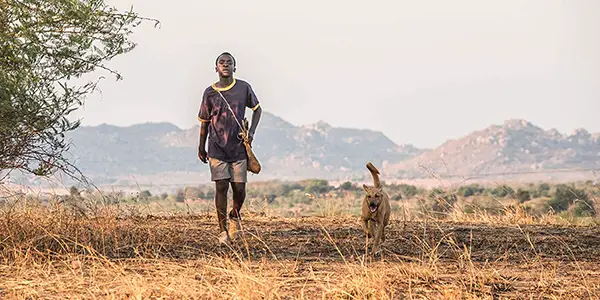Inspired, feel-good stories that also deal with devestating real-life situations are sometimes a difficult tightrope to walk. There must be just enough desperation within the story itself, yet without becoming too dismal, in order for it to fully succeed amongst audiences.
Such is the balance found in The Boy Who Harnessed the Wind, Chiwetel Ejiofor‘s directorial debut. Taking place in the early 2000’s in Kasungu, Malawi, it deals with a drought in a small village, which has many of the village’s inhabitants struggling to find adequate sustenance. While delving into this bleak reality, it also provides a light at the end of the tunnel, coming in the form of a young boy named William Kamkwamba.
The Power of Education
William (portrayed by newcomer Maxwell Simba) is an adolescent growing up in the village of Wimbe. Along with his sister Annie (Lily Banda) and parents Trywell (Ejiofor) and Agnes (Aissa Maiga), the family works as farmers, harvesting grain. Within recent years, drought has caused their crops to fail, leading the family to struggle for adequate food. The village around them is also going through the same, leading to riots and eventually a good portion of the community abandoning the town for more hopeful endeavours.
The young William is of a different mindset, though. During his tenure as a student, shut-lived due to his parents not being able to pay the school’s funds, he starts to develop ideas of his own. While studying in the school’s library, he realizes that he should be able to create energy through a windmill, and though he is at first not taken seriously, eventually the town, with little hope left, rallies behind him, praying that William will be able to help them all.

Even if you don’t know the story, it shouldn’t be too difficult to see just where The Boy Who Harnessed the Wind is headed from its outset (it’s in the name, after all). There are predictable obstacles on the way to William getting his goal, such as him not being able to study due to his family’s lack of finances and especially from his parents’ insistence that he instead help them with the crops. The scenes between William and his father, for example, in which his father is at first amused by his son’s inventive spirit but later angry about what he perceives to be his naivete, is as cookie-cutter as you might expect in a film of this nature.
What the film lacks in originality, though, it more than makes up for in the portrayal of William himself, who is an endearing presence by newcomer Maxwell Simba. As we soon come to see, William is quite a resourceful boy. He finds a way to get access to the school’s library, sneaks away from his required duties, and salvages through junkyards for parts to build his machine. He is, as The Daily Show’s Jon Stewart once stated when interviewing the real William on the show, a real-life MacGyver. It’s refreshing, in a movie such as this, to see a community, and one boy in particular, raise itself above its shortcomings, showing that sometimes it is by helping ouselves that we can achieve the most beneficial results.
Casting Africa
It’s also refreshing to see a story told like this set in Africa, and from the perspective of Africans as well, many of which, like Ejiofor, were born on the continent. The film is also quite sympathetic in its approach, showing the desperation of the town of Malawi, but showing its beating heart as well, especially from the central characters of the film through which we see the events unfold. Besides William and Trywell, Aïssa Maïga‘s Agnes is another standout character, whose firm confidence helps to set the stage for many of the conclusive events of the film.
Ejiofor‘s immersive approach doesn’t ask you to necessarily feel sorry for what the Kamkwambas and their village are going through; instead, he wants you to simply understand their situation, and perhaps realize that the things we take for granted, such as running water, adequate nutrition, etc., are not absolute guarantees in many communities around the world. But perhaps, with a solution like William’s windmill, it doesn’t need to be this way any longer.
Another example of the sincerity behind the film is the language spoken. With a majority of the film in Chichewa, one of the official languages of Malawi, the characters also flit back and forth between that and English, in a manner that is very true to life in communities where they speak multiple languages. In an interview on The Daily Show, Ejiofor explained to current host Trevor Noah that he did this because he wanted his film to be as realistic as possible, even going so far as to learn Chichewa for the film. It’s intricate details like this that help raise the film even more above its familiar trappings.
Conclusion: The Boy Who Harnessed the Wind
To conclude, The Boy Who Harnessed the Wind is a perfectly serviceable watch. Though delving into a dismal real-life situation, it retains a sense of empathy for its characters and for their plight throughout. As a result, its expectedly feel-good ending feels earned. When it comes down to it, you’ve seen this type of movie before, but rarely with this setting and with people from this part of the world. Chiwetel Ejiofor and William’s story have harnessed more than the wind; they might just harness your heart as well.
What are your thoughts on The Boy Who Harnessed the Wind? Are you a fan of feel-good biopics? Let us know in the comments below!
The Boy Who Harnessed the Wind is now available on Netflix.
Does content like this matter to you?
Become a Member and support film journalism. Unlock access to all of Film Inquiry`s great articles. Join a community of like-minded readers who are passionate about cinema - get access to our private members Network, give back to independent filmmakers, and more.